Basic Concepts of Accounting and Adjustment Journal Entries
VerifiedAdded on 2023/06/07
|12
|2396
|79
AI Summary
This assignment explains the basic concepts of accounting, adjustment journal entries, trial balance, adjusted trial balance, income statement, and balance sheet. It also includes examples and working notes for better understanding. The subject is Business Accounting with course code 1.
Contribute Materials
Your contribution can guide someone’s learning journey. Share your
documents today.

Business Accounting
1
1
Secure Best Marks with AI Grader
Need help grading? Try our AI Grader for instant feedback on your assignments.
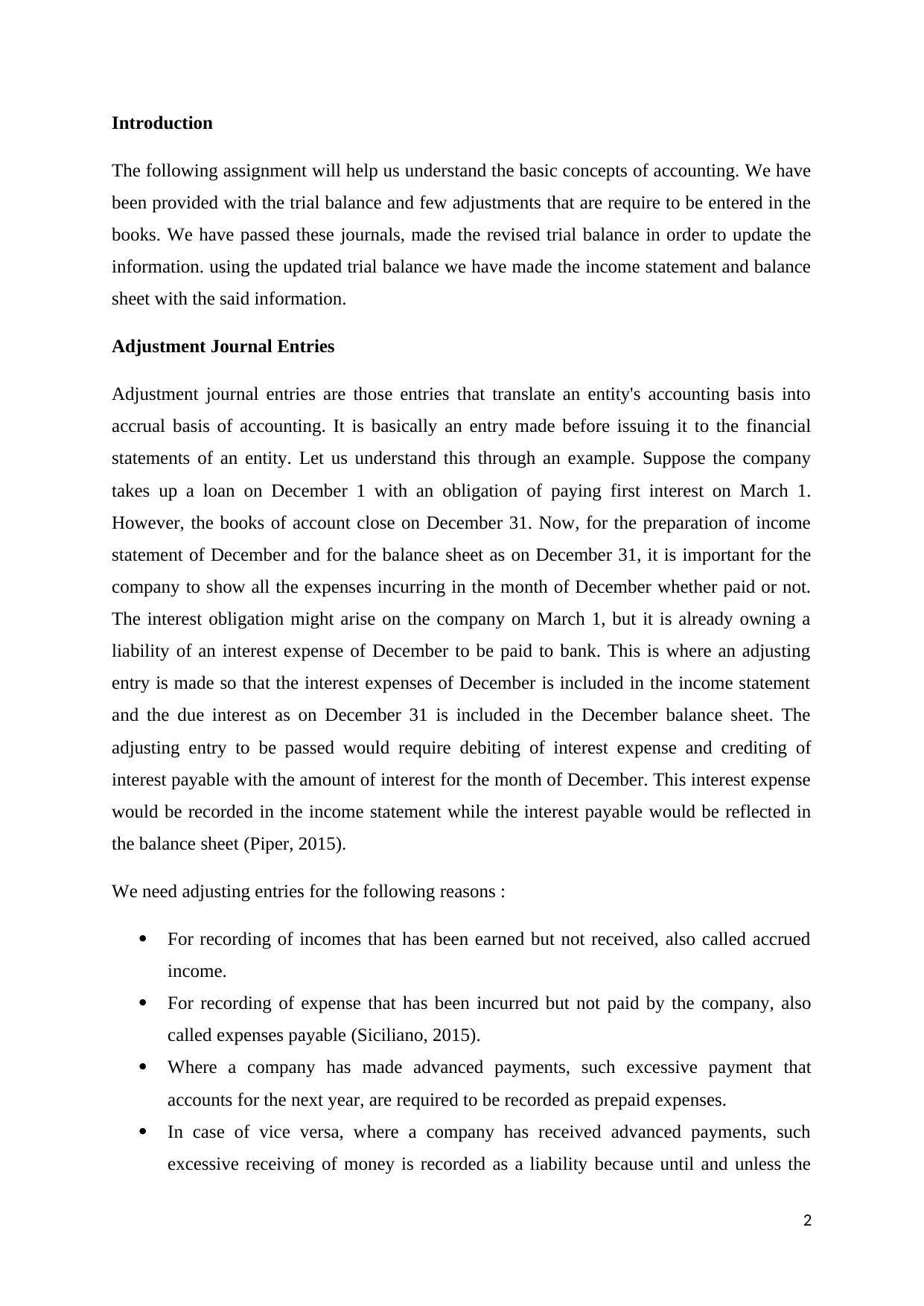
Introduction
The following assignment will help us understand the basic concepts of accounting. We have
been provided with the trial balance and few adjustments that are require to be entered in the
books. We have passed these journals, made the revised trial balance in order to update the
information. using the updated trial balance we have made the income statement and balance
sheet with the said information.
Adjustment Journal Entries
Adjustment journal entries are those entries that translate an entity's accounting basis into
accrual basis of accounting. It is basically an entry made before issuing it to the financial
statements of an entity. Let us understand this through an example. Suppose the company
takes up a loan on December 1 with an obligation of paying first interest on March 1.
However, the books of account close on December 31. Now, for the preparation of income
statement of December and for the balance sheet as on December 31, it is important for the
company to show all the expenses incurring in the month of December whether paid or not.
The interest obligation might arise on the company on March 1, but it is already owning a
liability of an interest expense of December to be paid to bank. This is where an adjusting
entry is made so that the interest expenses of December is included in the income statement
and the due interest as on December 31 is included in the December balance sheet. The
adjusting entry to be passed would require debiting of interest expense and crediting of
interest payable with the amount of interest for the month of December. This interest expense
would be recorded in the income statement while the interest payable would be reflected in
the balance sheet (Piper, 2015).
We need adjusting entries for the following reasons :
For recording of incomes that has been earned but not received, also called accrued
income.
For recording of expense that has been incurred but not paid by the company, also
called expenses payable (Siciliano, 2015).
Where a company has made advanced payments, such excessive payment that
accounts for the next year, are required to be recorded as prepaid expenses.
In case of vice versa, where a company has received advanced payments, such
excessive receiving of money is recorded as a liability because until and unless the
2
The following assignment will help us understand the basic concepts of accounting. We have
been provided with the trial balance and few adjustments that are require to be entered in the
books. We have passed these journals, made the revised trial balance in order to update the
information. using the updated trial balance we have made the income statement and balance
sheet with the said information.
Adjustment Journal Entries
Adjustment journal entries are those entries that translate an entity's accounting basis into
accrual basis of accounting. It is basically an entry made before issuing it to the financial
statements of an entity. Let us understand this through an example. Suppose the company
takes up a loan on December 1 with an obligation of paying first interest on March 1.
However, the books of account close on December 31. Now, for the preparation of income
statement of December and for the balance sheet as on December 31, it is important for the
company to show all the expenses incurring in the month of December whether paid or not.
The interest obligation might arise on the company on March 1, but it is already owning a
liability of an interest expense of December to be paid to bank. This is where an adjusting
entry is made so that the interest expenses of December is included in the income statement
and the due interest as on December 31 is included in the December balance sheet. The
adjusting entry to be passed would require debiting of interest expense and crediting of
interest payable with the amount of interest for the month of December. This interest expense
would be recorded in the income statement while the interest payable would be reflected in
the balance sheet (Piper, 2015).
We need adjusting entries for the following reasons :
For recording of incomes that has been earned but not received, also called accrued
income.
For recording of expense that has been incurred but not paid by the company, also
called expenses payable (Siciliano, 2015).
Where a company has made advanced payments, such excessive payment that
accounts for the next year, are required to be recorded as prepaid expenses.
In case of vice versa, where a company has received advanced payments, such
excessive receiving of money is recorded as a liability because until and unless the
2
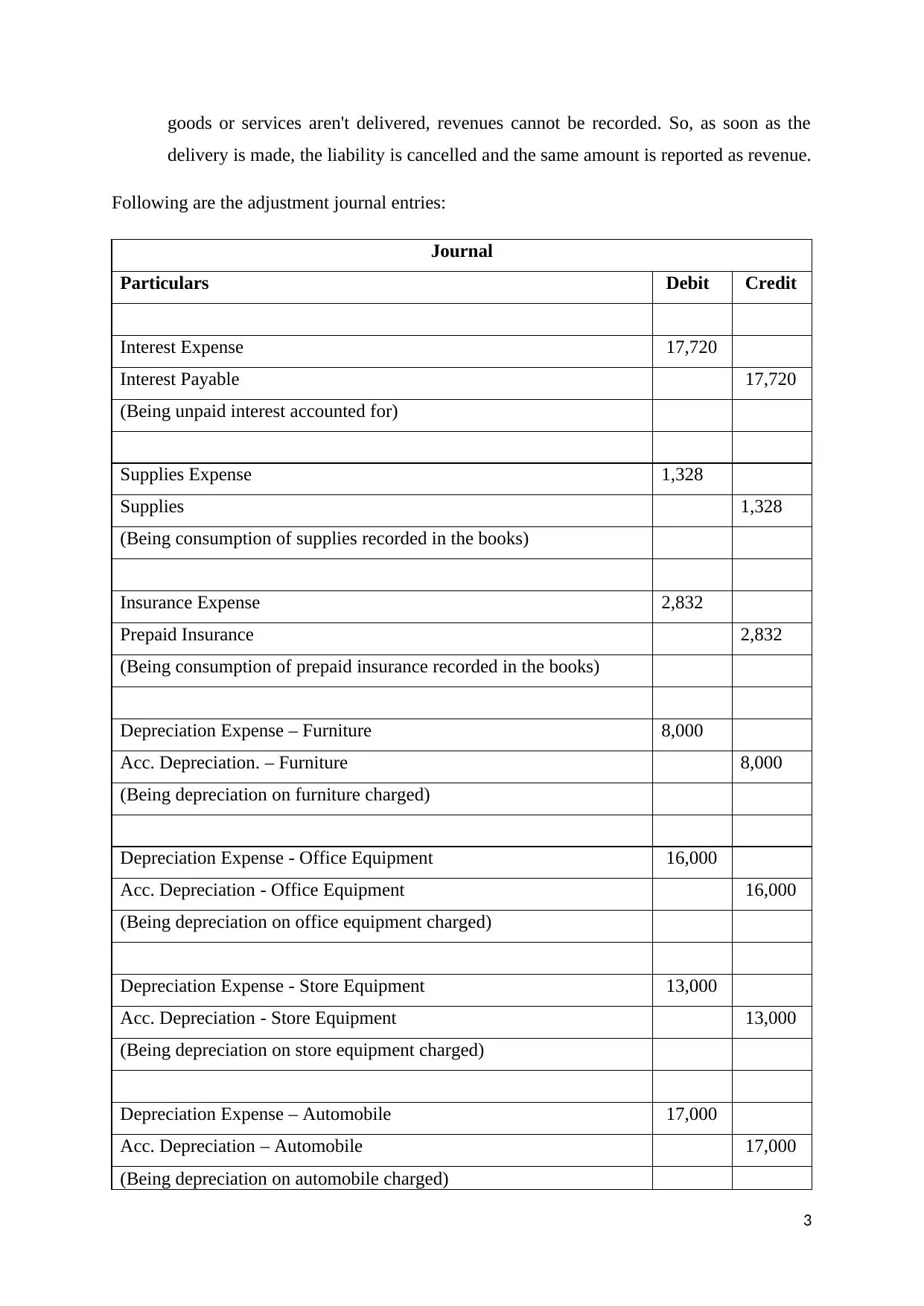
goods or services aren't delivered, revenues cannot be recorded. So, as soon as the
delivery is made, the liability is cancelled and the same amount is reported as revenue.
Following are the adjustment journal entries:
Journal
Particulars Debit Credit
Interest Expense 17,720
Interest Payable 17,720
(Being unpaid interest accounted for)
Supplies Expense 1,328
Supplies 1,328
(Being consumption of supplies recorded in the books)
Insurance Expense 2,832
Prepaid Insurance 2,832
(Being consumption of prepaid insurance recorded in the books)
Depreciation Expense – Furniture 8,000
Acc. Depreciation. – Furniture 8,000
(Being depreciation on furniture charged)
Depreciation Expense - Office Equipment 16,000
Acc. Depreciation - Office Equipment 16,000
(Being depreciation on office equipment charged)
Depreciation Expense - Store Equipment 13,000
Acc. Depreciation - Store Equipment 13,000
(Being depreciation on store equipment charged)
Depreciation Expense – Automobile 17,000
Acc. Depreciation – Automobile 17,000
(Being depreciation on automobile charged)
3
delivery is made, the liability is cancelled and the same amount is reported as revenue.
Following are the adjustment journal entries:
Journal
Particulars Debit Credit
Interest Expense 17,720
Interest Payable 17,720
(Being unpaid interest accounted for)
Supplies Expense 1,328
Supplies 1,328
(Being consumption of supplies recorded in the books)
Insurance Expense 2,832
Prepaid Insurance 2,832
(Being consumption of prepaid insurance recorded in the books)
Depreciation Expense – Furniture 8,000
Acc. Depreciation. – Furniture 8,000
(Being depreciation on furniture charged)
Depreciation Expense - Office Equipment 16,000
Acc. Depreciation - Office Equipment 16,000
(Being depreciation on office equipment charged)
Depreciation Expense - Store Equipment 13,000
Acc. Depreciation - Store Equipment 13,000
(Being depreciation on store equipment charged)
Depreciation Expense – Automobile 17,000
Acc. Depreciation – Automobile 17,000
(Being depreciation on automobile charged)
3
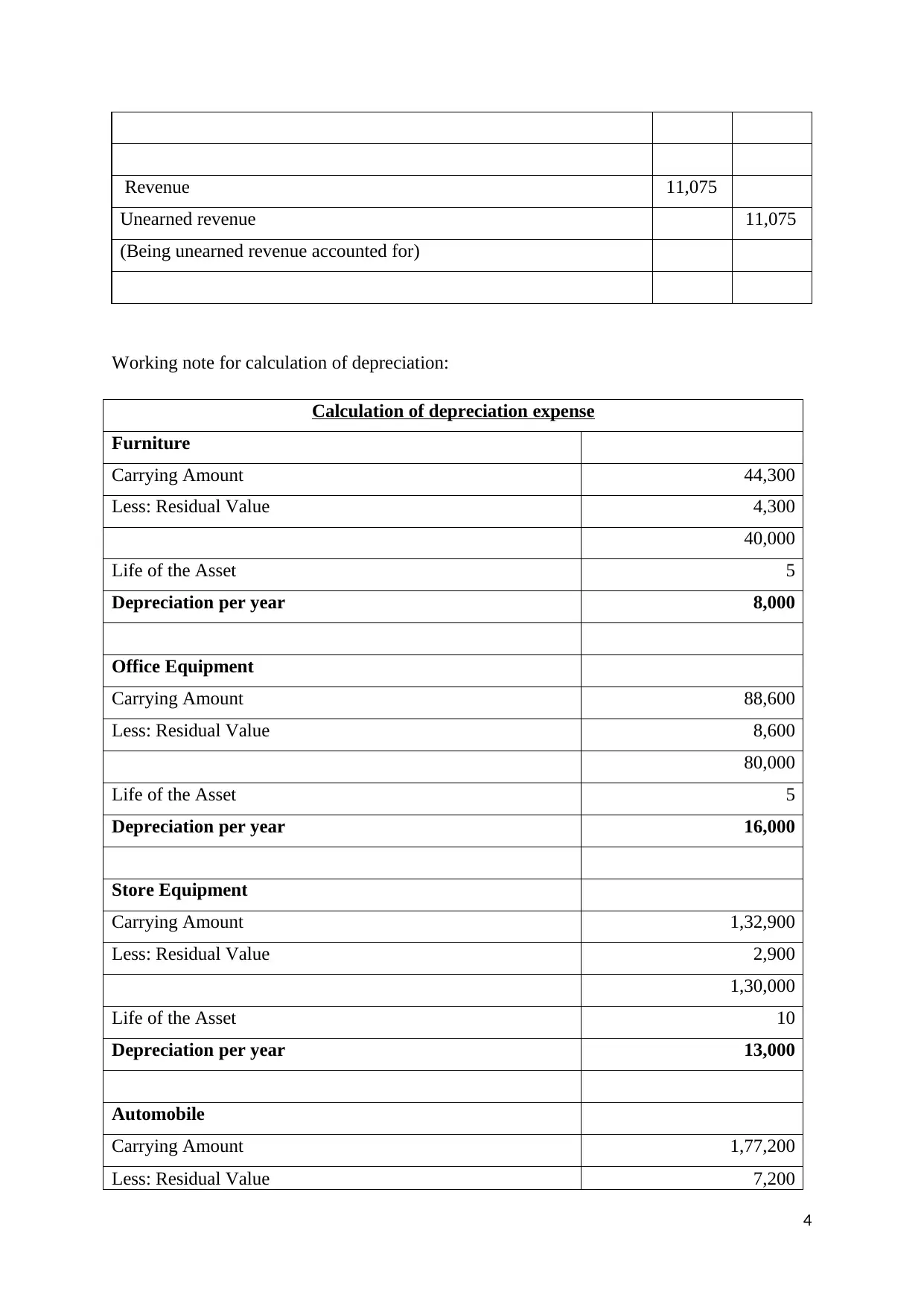
Revenue 11,075
Unearned revenue 11,075
(Being unearned revenue accounted for)
Working note for calculation of depreciation:
Calculation of depreciation expense
Furniture
Carrying Amount 44,300
Less: Residual Value 4,300
40,000
Life of the Asset 5
Depreciation per year 8,000
Office Equipment
Carrying Amount 88,600
Less: Residual Value 8,600
80,000
Life of the Asset 5
Depreciation per year 16,000
Store Equipment
Carrying Amount 1,32,900
Less: Residual Value 2,900
1,30,000
Life of the Asset 10
Depreciation per year 13,000
Automobile
Carrying Amount 1,77,200
Less: Residual Value 7,200
4
Unearned revenue 11,075
(Being unearned revenue accounted for)
Working note for calculation of depreciation:
Calculation of depreciation expense
Furniture
Carrying Amount 44,300
Less: Residual Value 4,300
40,000
Life of the Asset 5
Depreciation per year 8,000
Office Equipment
Carrying Amount 88,600
Less: Residual Value 8,600
80,000
Life of the Asset 5
Depreciation per year 16,000
Store Equipment
Carrying Amount 1,32,900
Less: Residual Value 2,900
1,30,000
Life of the Asset 10
Depreciation per year 13,000
Automobile
Carrying Amount 1,77,200
Less: Residual Value 7,200
4
Secure Best Marks with AI Grader
Need help grading? Try our AI Grader for instant feedback on your assignments.
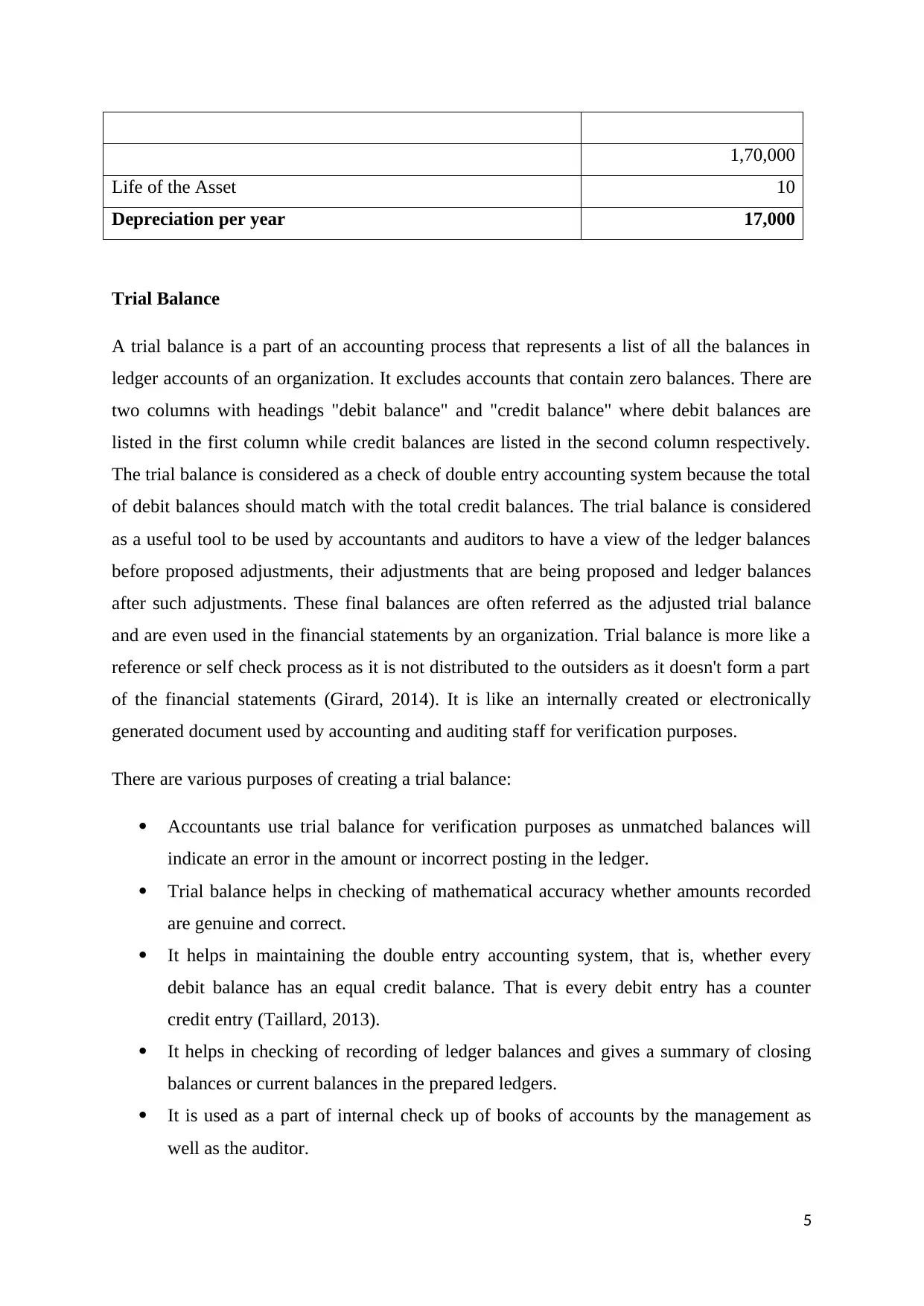
1,70,000
Life of the Asset 10
Depreciation per year 17,000
Trial Balance
A trial balance is a part of an accounting process that represents a list of all the balances in
ledger accounts of an organization. It excludes accounts that contain zero balances. There are
two columns with headings "debit balance" and "credit balance" where debit balances are
listed in the first column while credit balances are listed in the second column respectively.
The trial balance is considered as a check of double entry accounting system because the total
of debit balances should match with the total credit balances. The trial balance is considered
as a useful tool to be used by accountants and auditors to have a view of the ledger balances
before proposed adjustments, their adjustments that are being proposed and ledger balances
after such adjustments. These final balances are often referred as the adjusted trial balance
and are even used in the financial statements by an organization. Trial balance is more like a
reference or self check process as it is not distributed to the outsiders as it doesn't form a part
of the financial statements (Girard, 2014). It is like an internally created or electronically
generated document used by accounting and auditing staff for verification purposes.
There are various purposes of creating a trial balance:
Accountants use trial balance for verification purposes as unmatched balances will
indicate an error in the amount or incorrect posting in the ledger.
Trial balance helps in checking of mathematical accuracy whether amounts recorded
are genuine and correct.
It helps in maintaining the double entry accounting system, that is, whether every
debit balance has an equal credit balance. That is every debit entry has a counter
credit entry (Taillard, 2013).
It helps in checking of recording of ledger balances and gives a summary of closing
balances or current balances in the prepared ledgers.
It is used as a part of internal check up of books of accounts by the management as
well as the auditor.
5
Life of the Asset 10
Depreciation per year 17,000
Trial Balance
A trial balance is a part of an accounting process that represents a list of all the balances in
ledger accounts of an organization. It excludes accounts that contain zero balances. There are
two columns with headings "debit balance" and "credit balance" where debit balances are
listed in the first column while credit balances are listed in the second column respectively.
The trial balance is considered as a check of double entry accounting system because the total
of debit balances should match with the total credit balances. The trial balance is considered
as a useful tool to be used by accountants and auditors to have a view of the ledger balances
before proposed adjustments, their adjustments that are being proposed and ledger balances
after such adjustments. These final balances are often referred as the adjusted trial balance
and are even used in the financial statements by an organization. Trial balance is more like a
reference or self check process as it is not distributed to the outsiders as it doesn't form a part
of the financial statements (Girard, 2014). It is like an internally created or electronically
generated document used by accounting and auditing staff for verification purposes.
There are various purposes of creating a trial balance:
Accountants use trial balance for verification purposes as unmatched balances will
indicate an error in the amount or incorrect posting in the ledger.
Trial balance helps in checking of mathematical accuracy whether amounts recorded
are genuine and correct.
It helps in maintaining the double entry accounting system, that is, whether every
debit balance has an equal credit balance. That is every debit entry has a counter
credit entry (Taillard, 2013).
It helps in checking of recording of ledger balances and gives a summary of closing
balances or current balances in the prepared ledgers.
It is used as a part of internal check up of books of accounts by the management as
well as the auditor.
5
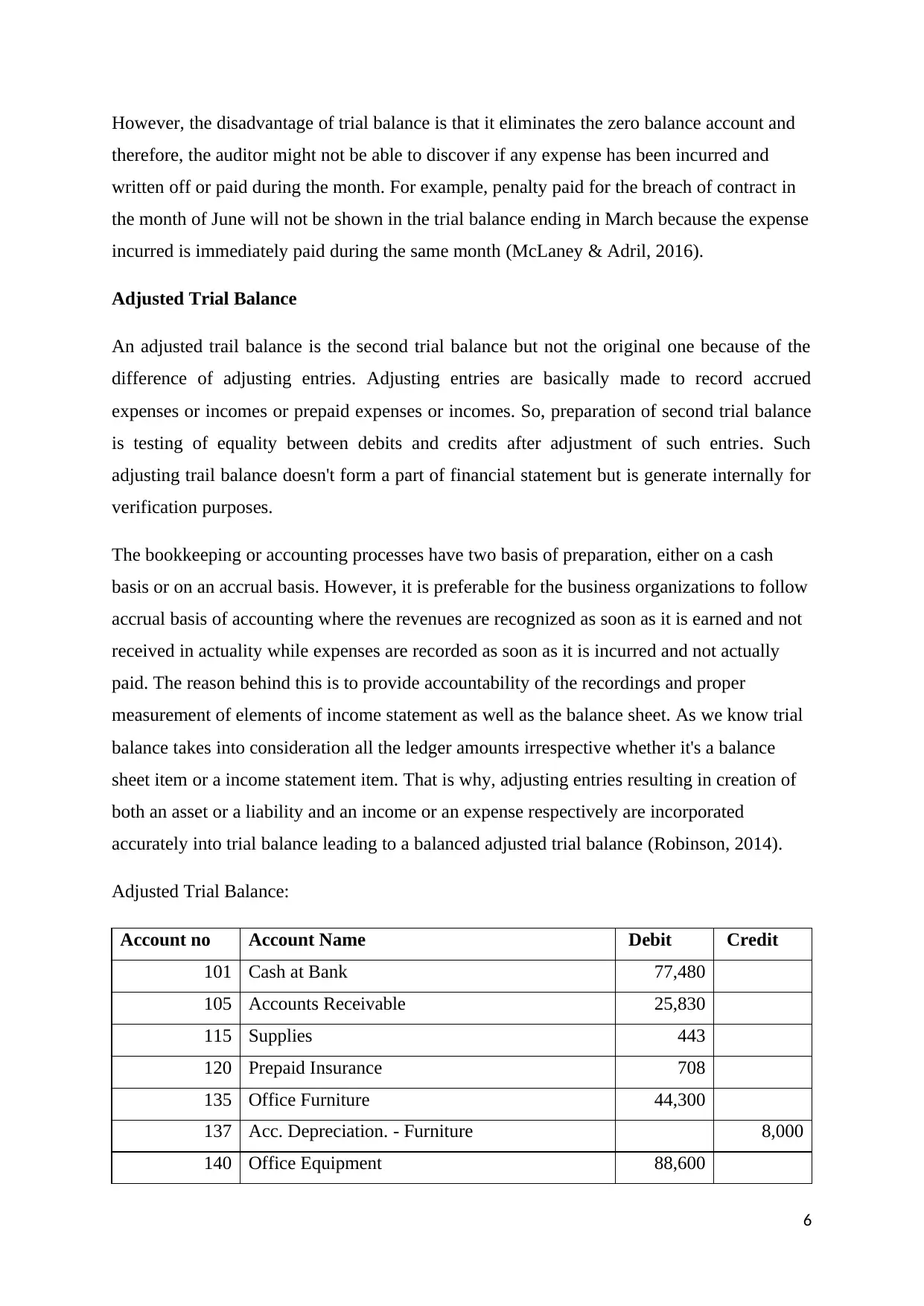
However, the disadvantage of trial balance is that it eliminates the zero balance account and
therefore, the auditor might not be able to discover if any expense has been incurred and
written off or paid during the month. For example, penalty paid for the breach of contract in
the month of June will not be shown in the trial balance ending in March because the expense
incurred is immediately paid during the same month (McLaney & Adril, 2016).
Adjusted Trial Balance
An adjusted trail balance is the second trial balance but not the original one because of the
difference of adjusting entries. Adjusting entries are basically made to record accrued
expenses or incomes or prepaid expenses or incomes. So, preparation of second trial balance
is testing of equality between debits and credits after adjustment of such entries. Such
adjusting trail balance doesn't form a part of financial statement but is generate internally for
verification purposes.
The bookkeeping or accounting processes have two basis of preparation, either on a cash
basis or on an accrual basis. However, it is preferable for the business organizations to follow
accrual basis of accounting where the revenues are recognized as soon as it is earned and not
received in actuality while expenses are recorded as soon as it is incurred and not actually
paid. The reason behind this is to provide accountability of the recordings and proper
measurement of elements of income statement as well as the balance sheet. As we know trial
balance takes into consideration all the ledger amounts irrespective whether it's a balance
sheet item or a income statement item. That is why, adjusting entries resulting in creation of
both an asset or a liability and an income or an expense respectively are incorporated
accurately into trial balance leading to a balanced adjusted trial balance (Robinson, 2014).
Adjusted Trial Balance:
Account no Account Name Debit Credit
101 Cash at Bank 77,480
105 Accounts Receivable 25,830
115 Supplies 443
120 Prepaid Insurance 708
135 Office Furniture 44,300
137 Acc. Depreciation. - Furniture 8,000
140 Office Equipment 88,600
6
therefore, the auditor might not be able to discover if any expense has been incurred and
written off or paid during the month. For example, penalty paid for the breach of contract in
the month of June will not be shown in the trial balance ending in March because the expense
incurred is immediately paid during the same month (McLaney & Adril, 2016).
Adjusted Trial Balance
An adjusted trail balance is the second trial balance but not the original one because of the
difference of adjusting entries. Adjusting entries are basically made to record accrued
expenses or incomes or prepaid expenses or incomes. So, preparation of second trial balance
is testing of equality between debits and credits after adjustment of such entries. Such
adjusting trail balance doesn't form a part of financial statement but is generate internally for
verification purposes.
The bookkeeping or accounting processes have two basis of preparation, either on a cash
basis or on an accrual basis. However, it is preferable for the business organizations to follow
accrual basis of accounting where the revenues are recognized as soon as it is earned and not
received in actuality while expenses are recorded as soon as it is incurred and not actually
paid. The reason behind this is to provide accountability of the recordings and proper
measurement of elements of income statement as well as the balance sheet. As we know trial
balance takes into consideration all the ledger amounts irrespective whether it's a balance
sheet item or a income statement item. That is why, adjusting entries resulting in creation of
both an asset or a liability and an income or an expense respectively are incorporated
accurately into trial balance leading to a balanced adjusted trial balance (Robinson, 2014).
Adjusted Trial Balance:
Account no Account Name Debit Credit
101 Cash at Bank 77,480
105 Accounts Receivable 25,830
115 Supplies 443
120 Prepaid Insurance 708
135 Office Furniture 44,300
137 Acc. Depreciation. - Furniture 8,000
140 Office Equipment 88,600
6
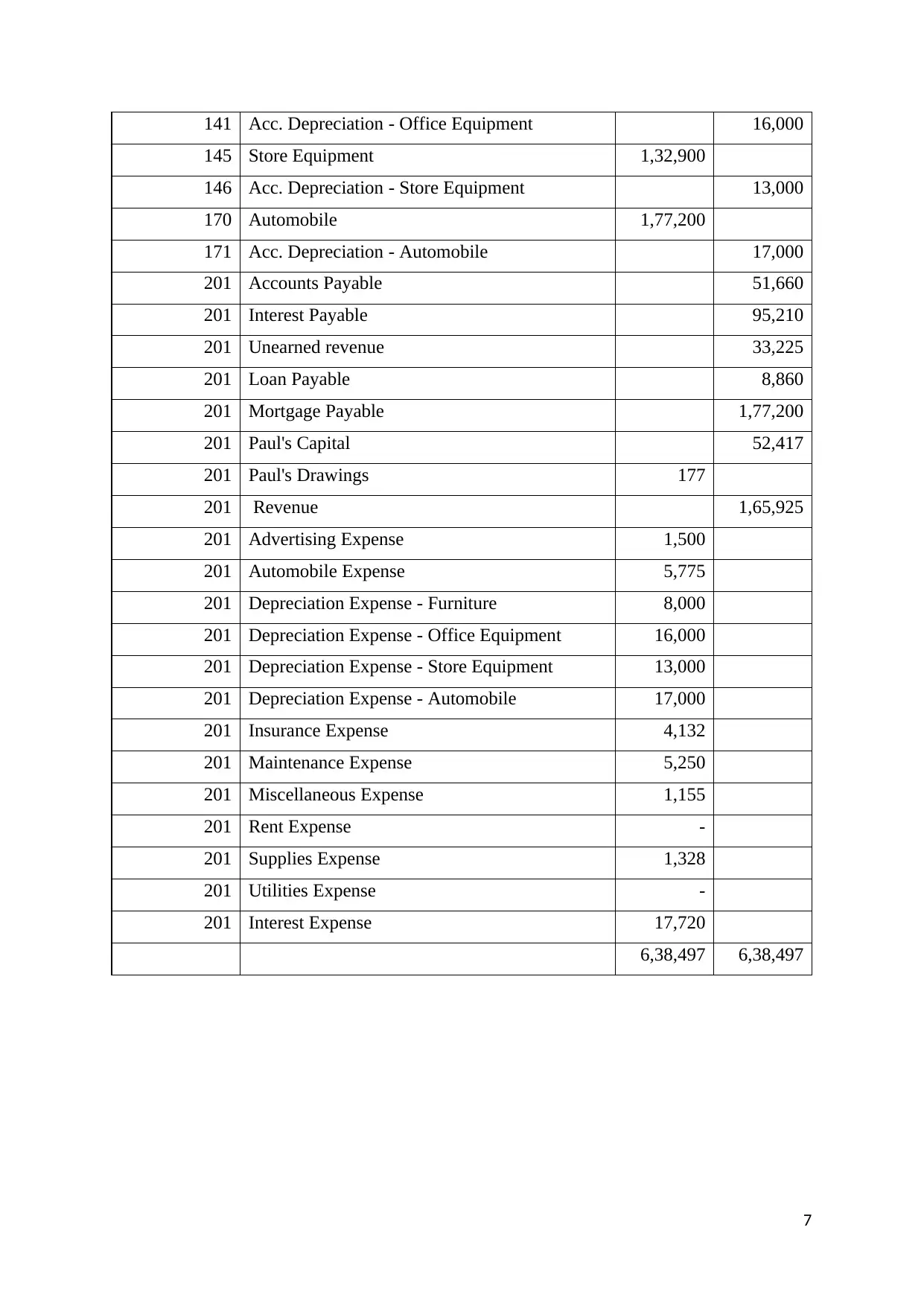
141 Acc. Depreciation - Office Equipment 16,000
145 Store Equipment 1,32,900
146 Acc. Depreciation - Store Equipment 13,000
170 Automobile 1,77,200
171 Acc. Depreciation - Automobile 17,000
201 Accounts Payable 51,660
201 Interest Payable 95,210
201 Unearned revenue 33,225
201 Loan Payable 8,860
201 Mortgage Payable 1,77,200
201 Paul's Capital 52,417
201 Paul's Drawings 177
201 Revenue 1,65,925
201 Advertising Expense 1,500
201 Automobile Expense 5,775
201 Depreciation Expense - Furniture 8,000
201 Depreciation Expense - Office Equipment 16,000
201 Depreciation Expense - Store Equipment 13,000
201 Depreciation Expense - Automobile 17,000
201 Insurance Expense 4,132
201 Maintenance Expense 5,250
201 Miscellaneous Expense 1,155
201 Rent Expense -
201 Supplies Expense 1,328
201 Utilities Expense -
201 Interest Expense 17,720
6,38,497 6,38,497
7
145 Store Equipment 1,32,900
146 Acc. Depreciation - Store Equipment 13,000
170 Automobile 1,77,200
171 Acc. Depreciation - Automobile 17,000
201 Accounts Payable 51,660
201 Interest Payable 95,210
201 Unearned revenue 33,225
201 Loan Payable 8,860
201 Mortgage Payable 1,77,200
201 Paul's Capital 52,417
201 Paul's Drawings 177
201 Revenue 1,65,925
201 Advertising Expense 1,500
201 Automobile Expense 5,775
201 Depreciation Expense - Furniture 8,000
201 Depreciation Expense - Office Equipment 16,000
201 Depreciation Expense - Store Equipment 13,000
201 Depreciation Expense - Automobile 17,000
201 Insurance Expense 4,132
201 Maintenance Expense 5,250
201 Miscellaneous Expense 1,155
201 Rent Expense -
201 Supplies Expense 1,328
201 Utilities Expense -
201 Interest Expense 17,720
6,38,497 6,38,497
7
Paraphrase This Document
Need a fresh take? Get an instant paraphrase of this document with our AI Paraphraser
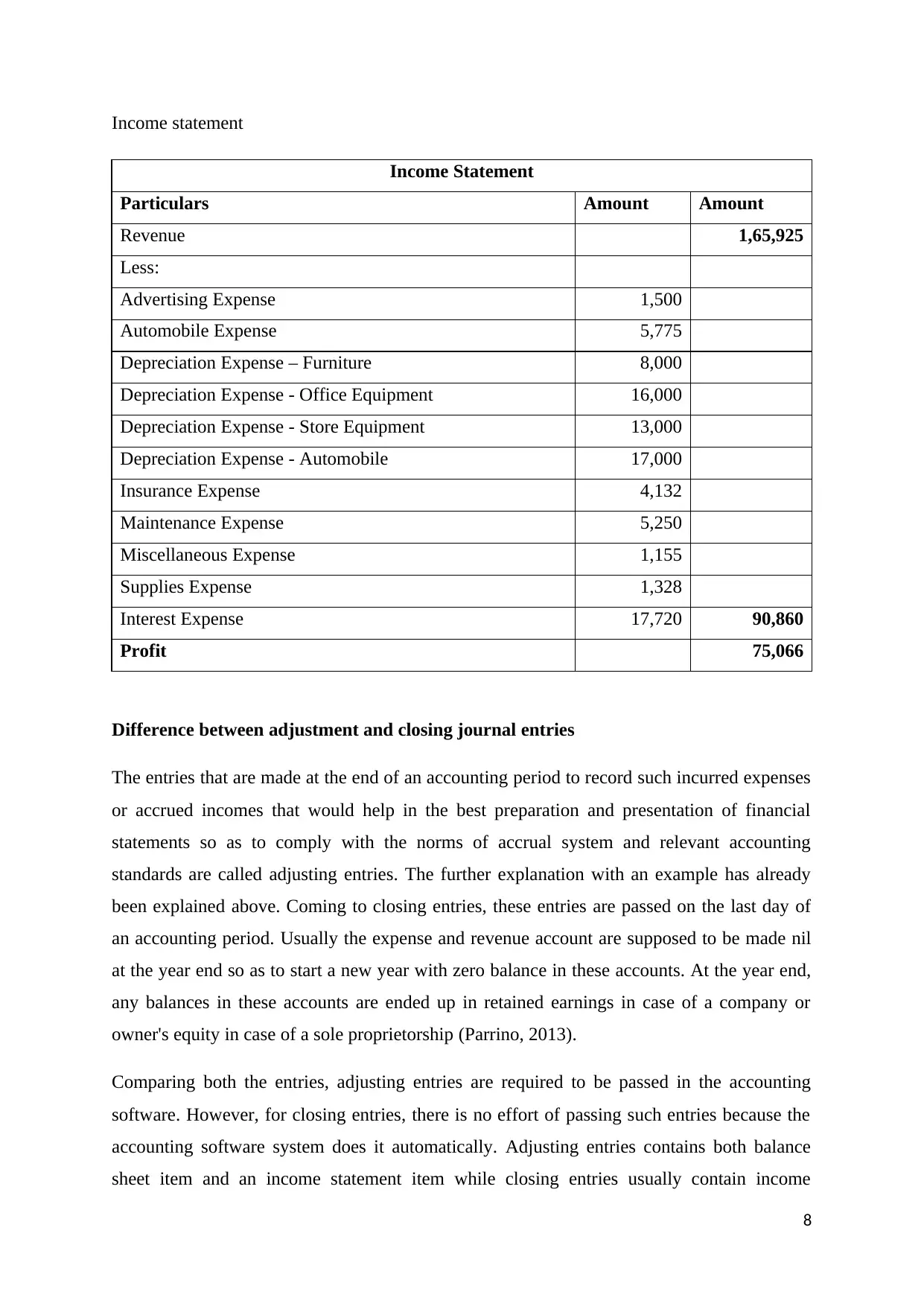
Income statement
Income Statement
Particulars Amount Amount
Revenue 1,65,925
Less:
Advertising Expense 1,500
Automobile Expense 5,775
Depreciation Expense – Furniture 8,000
Depreciation Expense - Office Equipment 16,000
Depreciation Expense - Store Equipment 13,000
Depreciation Expense - Automobile 17,000
Insurance Expense 4,132
Maintenance Expense 5,250
Miscellaneous Expense 1,155
Supplies Expense 1,328
Interest Expense 17,720 90,860
Profit 75,066
Difference between adjustment and closing journal entries
The entries that are made at the end of an accounting period to record such incurred expenses
or accrued incomes that would help in the best preparation and presentation of financial
statements so as to comply with the norms of accrual system and relevant accounting
standards are called adjusting entries. The further explanation with an example has already
been explained above. Coming to closing entries, these entries are passed on the last day of
an accounting period. Usually the expense and revenue account are supposed to be made nil
at the year end so as to start a new year with zero balance in these accounts. At the year end,
any balances in these accounts are ended up in retained earnings in case of a company or
owner's equity in case of a sole proprietorship (Parrino, 2013).
Comparing both the entries, adjusting entries are required to be passed in the accounting
software. However, for closing entries, there is no effort of passing such entries because the
accounting software system does it automatically. Adjusting entries contains both balance
sheet item and an income statement item while closing entries usually contain income
8
Income Statement
Particulars Amount Amount
Revenue 1,65,925
Less:
Advertising Expense 1,500
Automobile Expense 5,775
Depreciation Expense – Furniture 8,000
Depreciation Expense - Office Equipment 16,000
Depreciation Expense - Store Equipment 13,000
Depreciation Expense - Automobile 17,000
Insurance Expense 4,132
Maintenance Expense 5,250
Miscellaneous Expense 1,155
Supplies Expense 1,328
Interest Expense 17,720 90,860
Profit 75,066
Difference between adjustment and closing journal entries
The entries that are made at the end of an accounting period to record such incurred expenses
or accrued incomes that would help in the best preparation and presentation of financial
statements so as to comply with the norms of accrual system and relevant accounting
standards are called adjusting entries. The further explanation with an example has already
been explained above. Coming to closing entries, these entries are passed on the last day of
an accounting period. Usually the expense and revenue account are supposed to be made nil
at the year end so as to start a new year with zero balance in these accounts. At the year end,
any balances in these accounts are ended up in retained earnings in case of a company or
owner's equity in case of a sole proprietorship (Parrino, 2013).
Comparing both the entries, adjusting entries are required to be passed in the accounting
software. However, for closing entries, there is no effort of passing such entries because the
accounting software system does it automatically. Adjusting entries contains both balance
sheet item and an income statement item while closing entries usually contain income
8
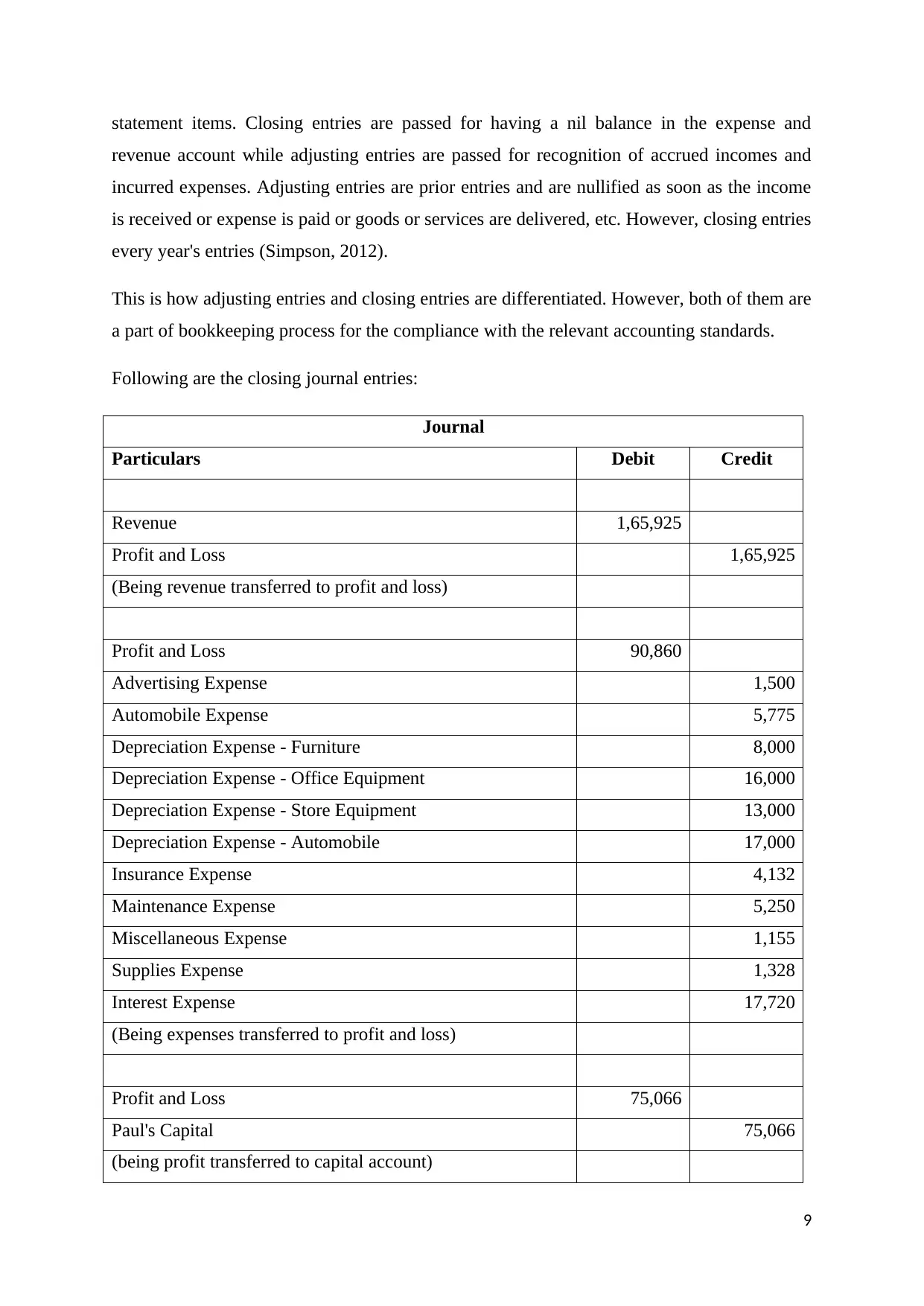
statement items. Closing entries are passed for having a nil balance in the expense and
revenue account while adjusting entries are passed for recognition of accrued incomes and
incurred expenses. Adjusting entries are prior entries and are nullified as soon as the income
is received or expense is paid or goods or services are delivered, etc. However, closing entries
every year's entries (Simpson, 2012).
This is how adjusting entries and closing entries are differentiated. However, both of them are
a part of bookkeeping process for the compliance with the relevant accounting standards.
Following are the closing journal entries:
Journal
Particulars Debit Credit
Revenue 1,65,925
Profit and Loss 1,65,925
(Being revenue transferred to profit and loss)
Profit and Loss 90,860
Advertising Expense 1,500
Automobile Expense 5,775
Depreciation Expense - Furniture 8,000
Depreciation Expense - Office Equipment 16,000
Depreciation Expense - Store Equipment 13,000
Depreciation Expense - Automobile 17,000
Insurance Expense 4,132
Maintenance Expense 5,250
Miscellaneous Expense 1,155
Supplies Expense 1,328
Interest Expense 17,720
(Being expenses transferred to profit and loss)
Profit and Loss 75,066
Paul's Capital 75,066
(being profit transferred to capital account)
9
revenue account while adjusting entries are passed for recognition of accrued incomes and
incurred expenses. Adjusting entries are prior entries and are nullified as soon as the income
is received or expense is paid or goods or services are delivered, etc. However, closing entries
every year's entries (Simpson, 2012).
This is how adjusting entries and closing entries are differentiated. However, both of them are
a part of bookkeeping process for the compliance with the relevant accounting standards.
Following are the closing journal entries:
Journal
Particulars Debit Credit
Revenue 1,65,925
Profit and Loss 1,65,925
(Being revenue transferred to profit and loss)
Profit and Loss 90,860
Advertising Expense 1,500
Automobile Expense 5,775
Depreciation Expense - Furniture 8,000
Depreciation Expense - Office Equipment 16,000
Depreciation Expense - Store Equipment 13,000
Depreciation Expense - Automobile 17,000
Insurance Expense 4,132
Maintenance Expense 5,250
Miscellaneous Expense 1,155
Supplies Expense 1,328
Interest Expense 17,720
(Being expenses transferred to profit and loss)
Profit and Loss 75,066
Paul's Capital 75,066
(being profit transferred to capital account)
9
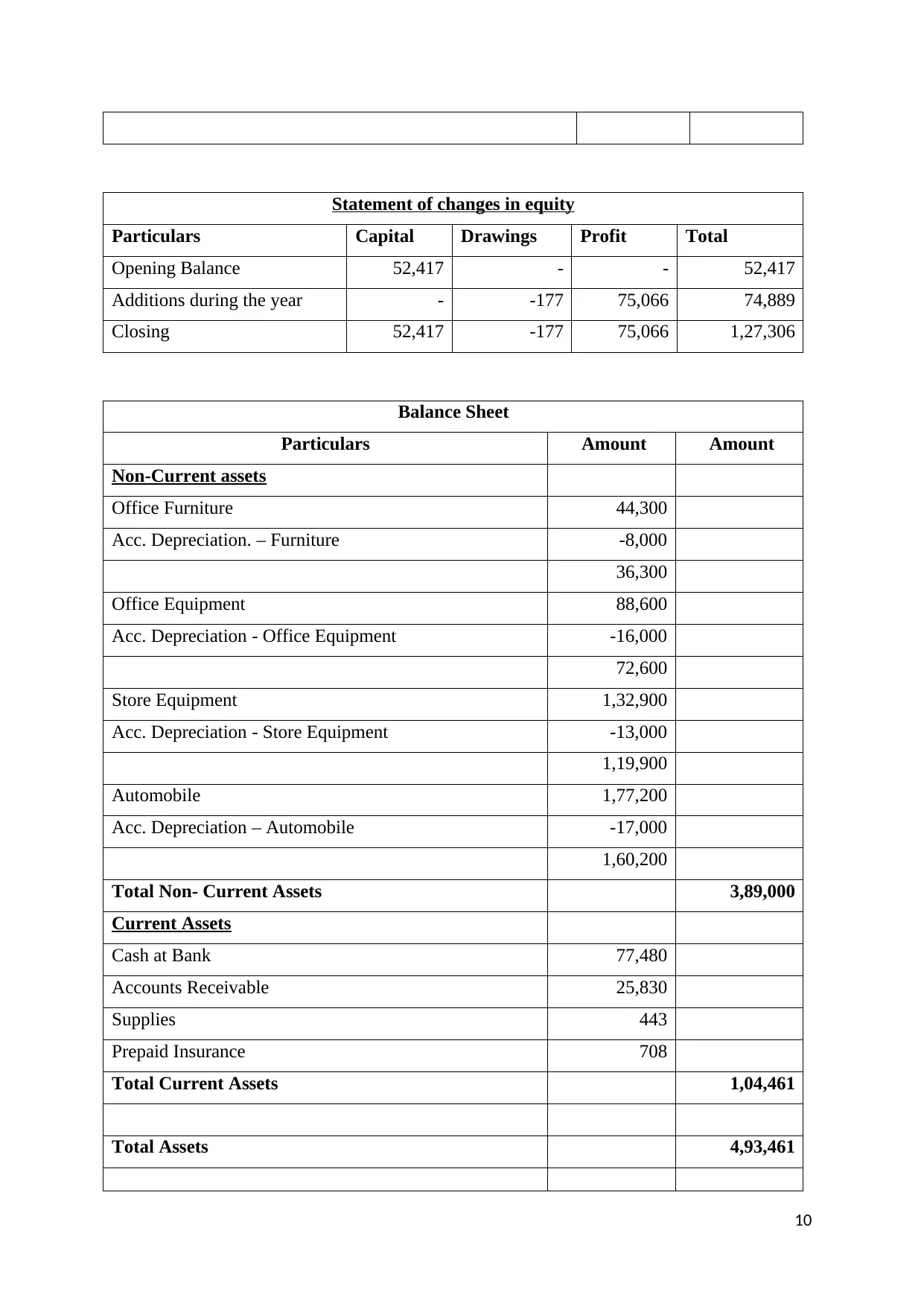
Statement of changes in equity
Particulars Capital Drawings Profit Total
Opening Balance 52,417 - - 52,417
Additions during the year - -177 75,066 74,889
Closing 52,417 -177 75,066 1,27,306
Balance Sheet
Particulars Amount Amount
Non-Current assets
Office Furniture 44,300
Acc. Depreciation. – Furniture -8,000
36,300
Office Equipment 88,600
Acc. Depreciation - Office Equipment -16,000
72,600
Store Equipment 1,32,900
Acc. Depreciation - Store Equipment -13,000
1,19,900
Automobile 1,77,200
Acc. Depreciation – Automobile -17,000
1,60,200
Total Non- Current Assets 3,89,000
Current Assets
Cash at Bank 77,480
Accounts Receivable 25,830
Supplies 443
Prepaid Insurance 708
Total Current Assets 1,04,461
Total Assets 4,93,461
10
Particulars Capital Drawings Profit Total
Opening Balance 52,417 - - 52,417
Additions during the year - -177 75,066 74,889
Closing 52,417 -177 75,066 1,27,306
Balance Sheet
Particulars Amount Amount
Non-Current assets
Office Furniture 44,300
Acc. Depreciation. – Furniture -8,000
36,300
Office Equipment 88,600
Acc. Depreciation - Office Equipment -16,000
72,600
Store Equipment 1,32,900
Acc. Depreciation - Store Equipment -13,000
1,19,900
Automobile 1,77,200
Acc. Depreciation – Automobile -17,000
1,60,200
Total Non- Current Assets 3,89,000
Current Assets
Cash at Bank 77,480
Accounts Receivable 25,830
Supplies 443
Prepaid Insurance 708
Total Current Assets 1,04,461
Total Assets 4,93,461
10
Secure Best Marks with AI Grader
Need help grading? Try our AI Grader for instant feedback on your assignments.
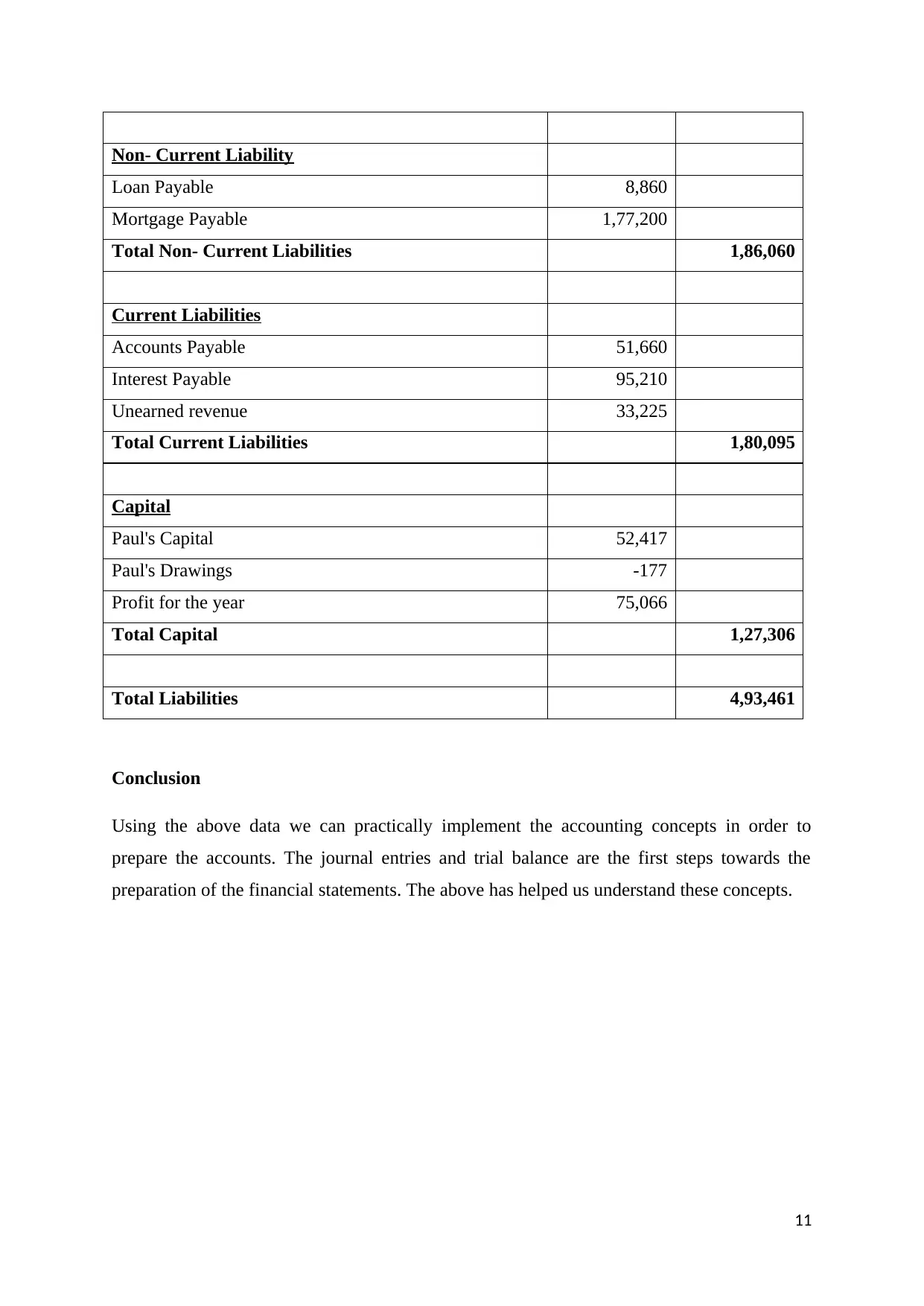
Non- Current Liability
Loan Payable 8,860
Mortgage Payable 1,77,200
Total Non- Current Liabilities 1,86,060
Current Liabilities
Accounts Payable 51,660
Interest Payable 95,210
Unearned revenue 33,225
Total Current Liabilities 1,80,095
Capital
Paul's Capital 52,417
Paul's Drawings -177
Profit for the year 75,066
Total Capital 1,27,306
Total Liabilities 4,93,461
Conclusion
Using the above data we can practically implement the accounting concepts in order to
prepare the accounts. The journal entries and trial balance are the first steps towards the
preparation of the financial statements. The above has helped us understand these concepts.
11
Loan Payable 8,860
Mortgage Payable 1,77,200
Total Non- Current Liabilities 1,86,060
Current Liabilities
Accounts Payable 51,660
Interest Payable 95,210
Unearned revenue 33,225
Total Current Liabilities 1,80,095
Capital
Paul's Capital 52,417
Paul's Drawings -177
Profit for the year 75,066
Total Capital 1,27,306
Total Liabilities 4,93,461
Conclusion
Using the above data we can practically implement the accounting concepts in order to
prepare the accounts. The journal entries and trial balance are the first steps towards the
preparation of the financial statements. The above has helped us understand these concepts.
11
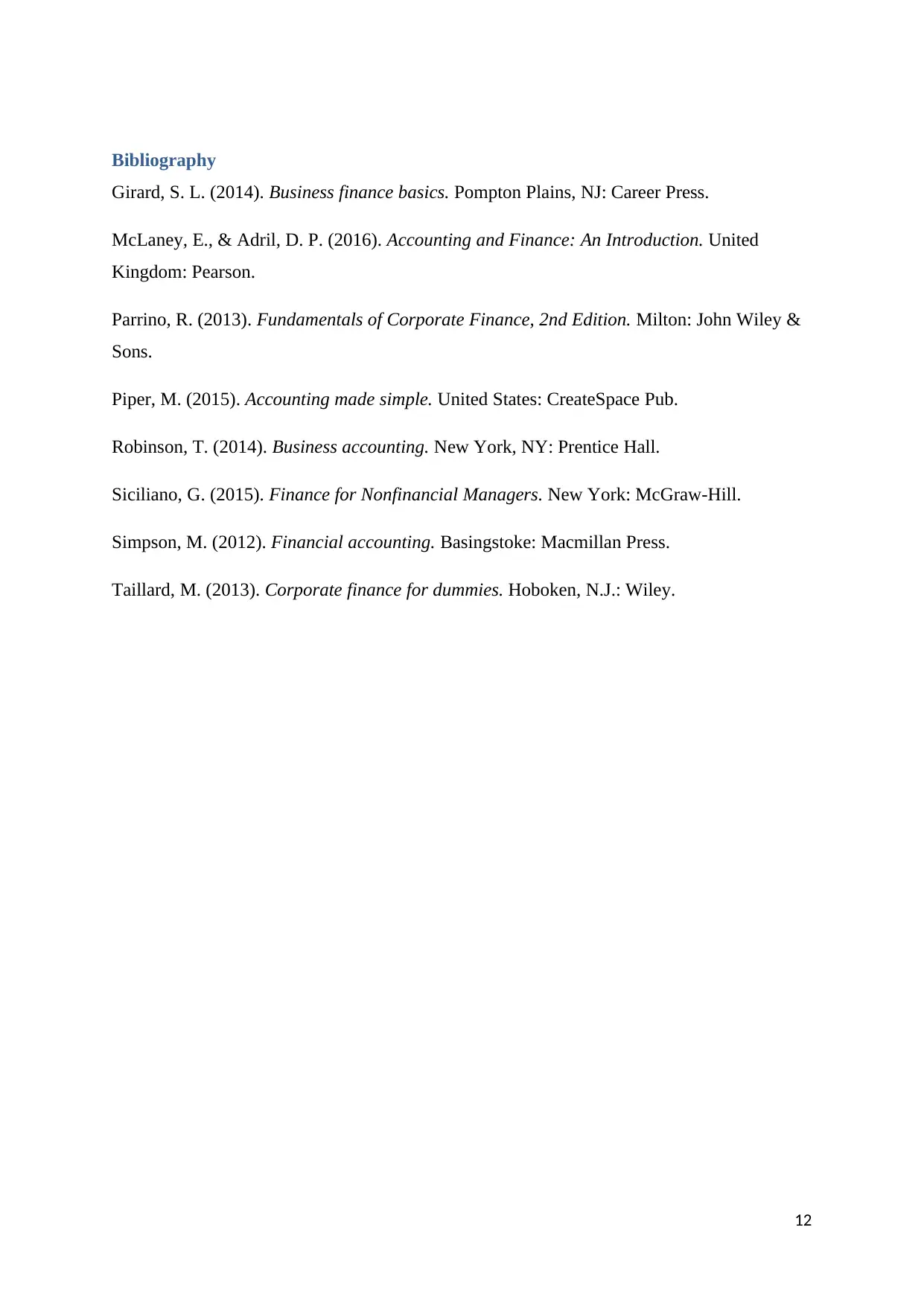
Bibliography
Girard, S. L. (2014). Business finance basics. Pompton Plains, NJ: Career Press.
McLaney, E., & Adril, D. P. (2016). Accounting and Finance: An Introduction. United
Kingdom: Pearson.
Parrino, R. (2013). Fundamentals of Corporate Finance, 2nd Edition. Milton: John Wiley &
Sons.
Piper, M. (2015). Accounting made simple. United States: CreateSpace Pub.
Robinson, T. (2014). Business accounting. New York, NY: Prentice Hall.
Siciliano, G. (2015). Finance for Nonfinancial Managers. New York: McGraw-Hill.
Simpson, M. (2012). Financial accounting. Basingstoke: Macmillan Press.
Taillard, M. (2013). Corporate finance for dummies. Hoboken, N.J.: Wiley.
12
Girard, S. L. (2014). Business finance basics. Pompton Plains, NJ: Career Press.
McLaney, E., & Adril, D. P. (2016). Accounting and Finance: An Introduction. United
Kingdom: Pearson.
Parrino, R. (2013). Fundamentals of Corporate Finance, 2nd Edition. Milton: John Wiley &
Sons.
Piper, M. (2015). Accounting made simple. United States: CreateSpace Pub.
Robinson, T. (2014). Business accounting. New York, NY: Prentice Hall.
Siciliano, G. (2015). Finance for Nonfinancial Managers. New York: McGraw-Hill.
Simpson, M. (2012). Financial accounting. Basingstoke: Macmillan Press.
Taillard, M. (2013). Corporate finance for dummies. Hoboken, N.J.: Wiley.
12
1 out of 12
Related Documents
Your All-in-One AI-Powered Toolkit for Academic Success.
+13062052269
info@desklib.com
Available 24*7 on WhatsApp / Email
![[object Object]](/_next/static/media/star-bottom.7253800d.svg)
Unlock your academic potential
© 2024 | Zucol Services PVT LTD | All rights reserved.





